They no longer weep, but we do.
Sunday, 6 March 2022
Rothbury's Armstrong Cottages at Townfoot
The gardens of the iconic Rothbury's Armstrong Cottages were home to two spectacular WEEPING ASH TREES. (Please note, this blog was written in May 2022, before they were felled).
Rothbury's Armstrong Cottages (built as alms houses in 1896) are among the most attractive and iconic buildings in this town. The cottages are situated at Town Foot, opposite the floodgates. Within the grounds of the cottages are two, rather beautiful and imposing, weeping ash trees. Note: There were two beautiful weeping ash, but they are no longer there (spring, 2024). This blog tells about the history of cottages, and about the origins of weeping ash trees.

In the photograph above you can see the Armstrong Cottages, with no Holly or Weeping Ash Trees yet planted. (Note that there are no stepping stones across the Coquet either).


C1913 showing the old fire engine, PC Sinton, a holly tree, and one of the weeping ash trees.
To the right of Armstrong Cottages are three houses, Riverdale. However, before being divided into three private dwellings, these buildings were Rothbury Union Workhouse.
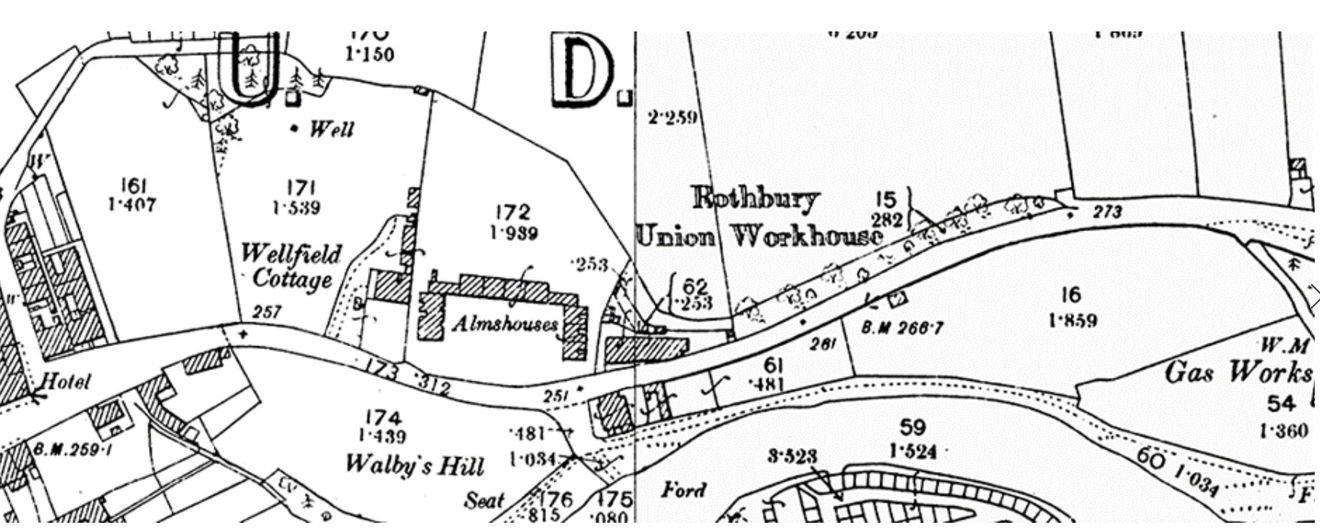
Armstrong Cottages comprise six dwellings facing the road, and three on each side. They were listed as Grade II by Historic England in 1987. The buildings are rock-faced stone with red clay tile roofs. A plaque in the centre of the cottages reads: “Erected by William George Baron Armstrong of Cragside in memory of Ann Armstrong his much loved mother 1896”
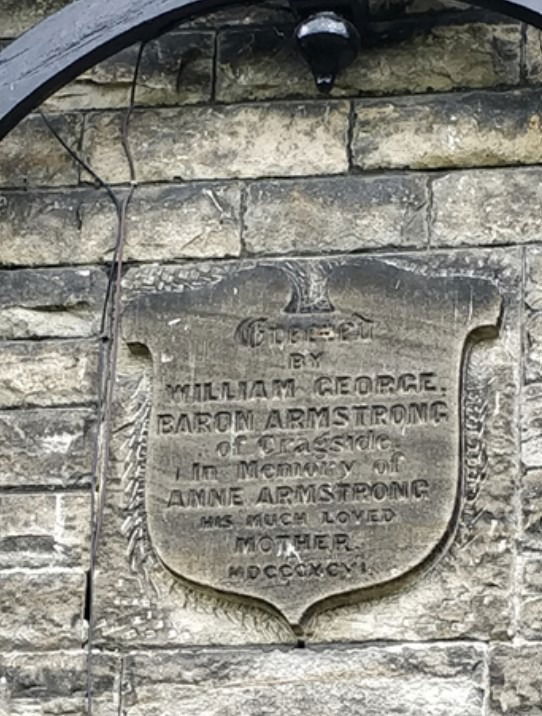

Portrait of Ann Armstrong, mother of William, 1st Baron Armstrong.
A report on an archaeological building recording project by Fiona Wooler of North Pennines Archaeology Ltd in 2009 gives us a lot of fascinating insights into these homes.
...Armstrong Cottages were constructed in a single phase as 12 single-storey cottages, U-shaped in plan and set back from the main road into Rothbury. To the front of the cottages is a large lawned area with symmetrical gravel paths and foliage, a central entrance gate focuses on a large gable in the south elevation which has an inscribed tablet containing the date 1896. The cottages were constructed with architectural elements which appear to echo those used in the main house at Cragside, such as dominating gables, prominent chimneys, mullioned windows and decorative bargeboards. They are, however, not as architectural in detail as the earlier Addycombe Cottages (1870s) located just to the north of Armstrong Cottages, which were designed by Norman Shaw, the same architect as the picturesque house at Cragside.
Of the twelve cottages, six are relatively small having only three rooms, and therefore possibly designed for single occupancy. The six cottages which make up the long range are larger, having an extra room suggesting there were meant for two or more occupants. The original function of each of the rooms is not known, however it is likely that each room served several functions, for example the main living area which faces the lawn to the front may also have been used for cooking and sleeping.
Armstrong Cottages are a nice example of housing provided by a philanthropic landowner, for retired workers from the estate. They are a continuation of a charitable tradition in Britain which dates back to the medieval period. These almshouses should not be seen in isolation; they form only part of the influence and affect the Armstrong family had on Rothbury and the surrounding area (North Pennines Archaeology Ltd, Oasis Ref: northpen3-54119)
Below is a list of people who were living in the cottages in 1901.
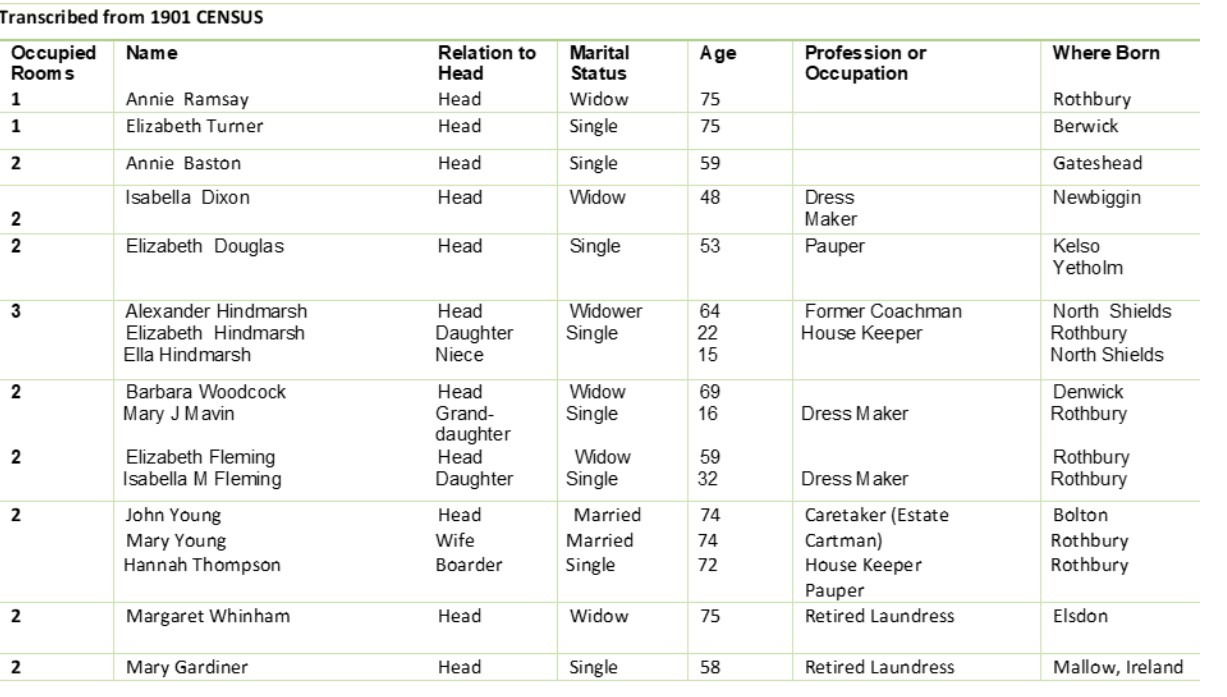
This shows that only 11 of the cottages were occupied at this date. Interesting also, is to observe the variety of people housed here. Note their different ages, and where they were originally from. Presumably, they had all worked at Cragside, for the Armstrongs. Three dressmakers, the oldest being 48, the youngest, 16. Also of interest is Hannah Thompson, and Elizabeth Douglas, both recorded as 'paupers'. It must have been of great comfort to them to be housed here, in these pretty cottages, instead of next door, at the Union Workhouse.
The Weeping Ash Trees
In summer 2021 I accompanied Nick Johnson of the Northumbria Veteran Tree project to survey these 'Notable' weeping ash trees, and he gauged their age to be around 110 years old. Northumbria Veteran Tree Project - Identifying veteran, heritage and notable trees across the regions of Newcastle, North Tyneside and Northumberland
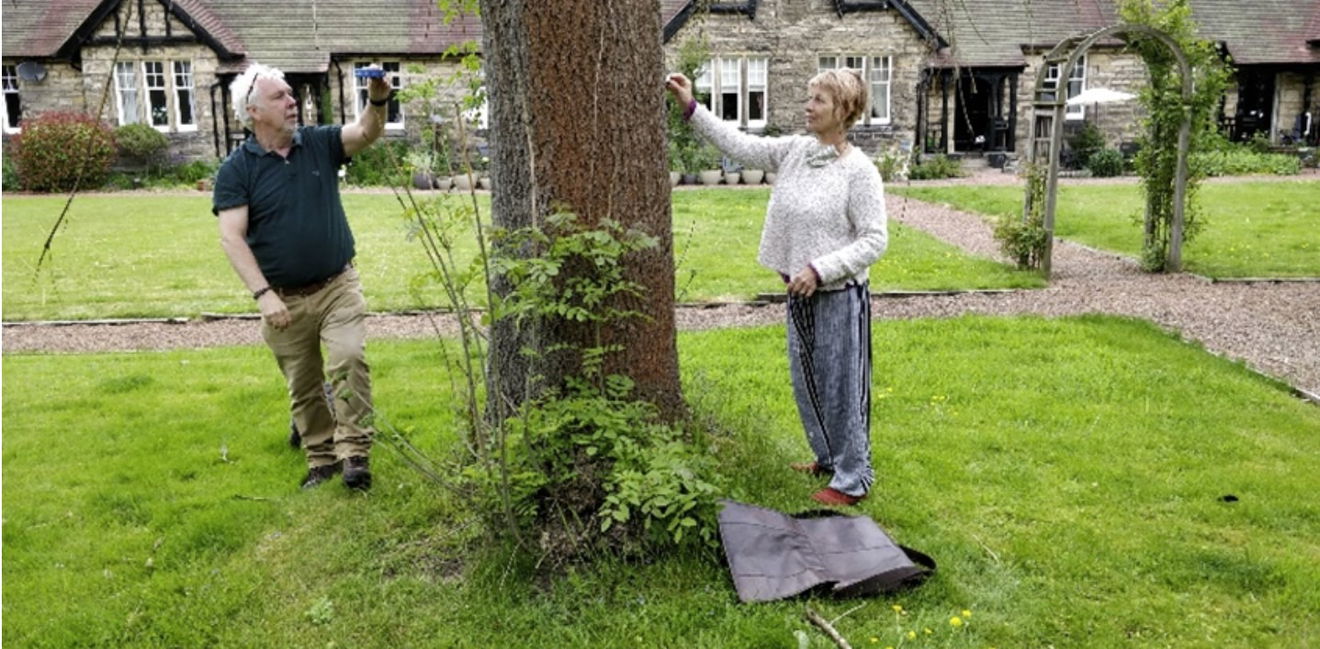
No doubt all these residents would have been most pleased and proud to have the two unusual and attractive trees planted in their front garden. I would love to discover who had chosen the weeping ash trees, and who planted them. (I intend to keep trying to find out! - if you have any ideas, please let me know). There are also two of a similar age in the lower section of Haw Hill graveyard. I guess they will have been planted at the same time, by the same person.
History of the weeping ash: Fraxinus excelsior pendula
Weeping ash trees gained popularity in the mid-1800s. It is not easy to find the exact origins of these decorative trees, the earliest reference I have been able to find is c1749. “Large natural weeping ash, near the middle of Glenquiech, on the left hand side of the road leading to Kenmore, and within fifty yards of it, is to be seen a natural Weeping Ash of a very large size, and probably a century old. The late Messrs Robert and James Brown of the Perth nurseries, directed our attention to this tree thirty years ago, and assured us that they had wrought hundreds of trees from it in their nurseries. We had an opportunity of visiting this fine old tree very lately, and found it in great health and vigour” North British Agriculturist 19.12.1849 See below:
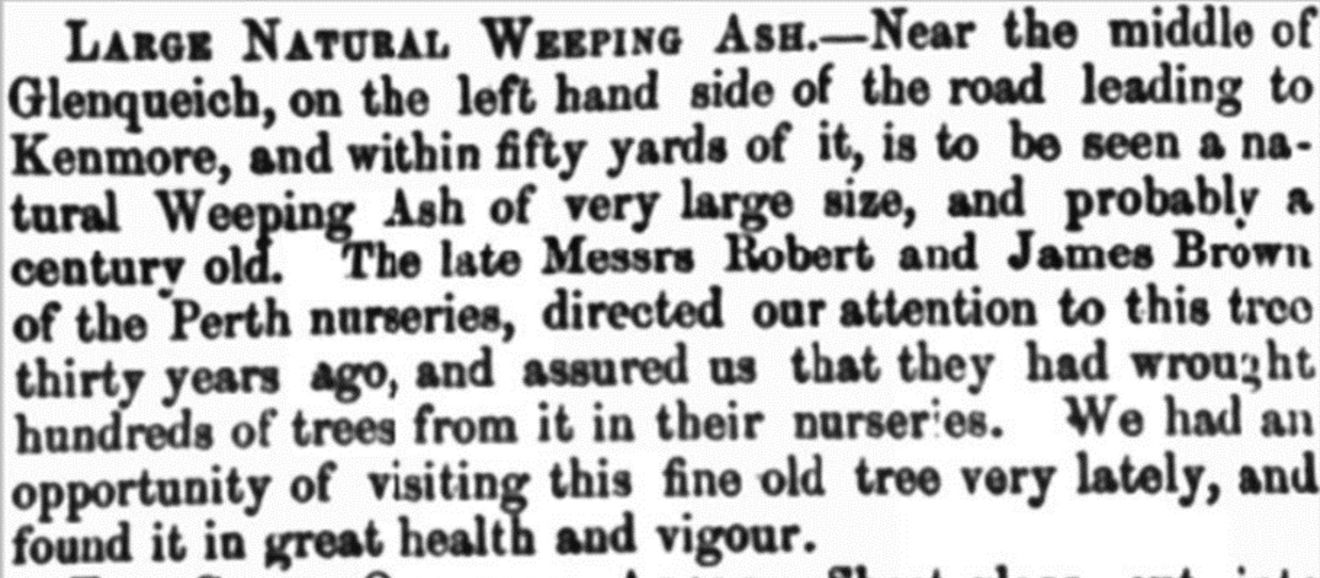
The branches of the weeping ash gracefully droop down. The Latin word 'pendula' in the name means 'hang down'. Weeping ash are created by grafting. This means combining one tree's qualities (weeping) with the roots of another that it strong and resilient (an ash tree). Some plants and trees grown this way do not produce seeds which will grow into the desired combination. However, my research uncovered that weeping ash were being successfully grown from seed (keys) as early as 1780.
Mr Anderson, Curator of the Botanic Garden, Chelsea, wrote to the Prussian Gardening Society “...Our gardeners...multiply no species so numerously as the Fraxinus Excelsior Varpendular (weeping ash) which variety often retains its hanging character when raised from seeds. We possess several such trees, about ten feet in height, which were raised from seed from the original tree, obtained in 1780 from a nurseryman, who found it a few years previous to that in the neighbourhood of Newmarket, in Cambridgeshire”. (Morning Post 14th October 1833)
A lot of newspapers, from all over England, reported on a magnificent Weeping Ash which was owned by the Duke of Devonshire. This tree was so admired by the Duke that he went to the considerable trouble of transplanting it from Derby to his mansion at Chatsworth.
The Cambridge Chronicle and Journal, 23.4.1830, told the story:

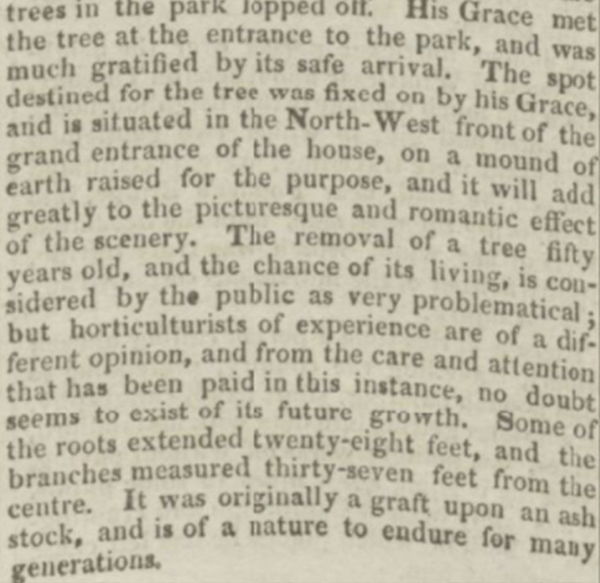
The Leicester Journal in 1830 reported on it once it had been transplanted: “The Weeping Ash...is in a most flourishing condition and appears not to have suffered in the least by its removal. The bird commonly known by the appellation of the storm cock has built its nest in the branches, and is rearing there a numerous progeny” An advertisement in Bath Chronicle and Weekly Gazette (26th November 1789) proclaims they have for sale the best ever of these trees for sale.
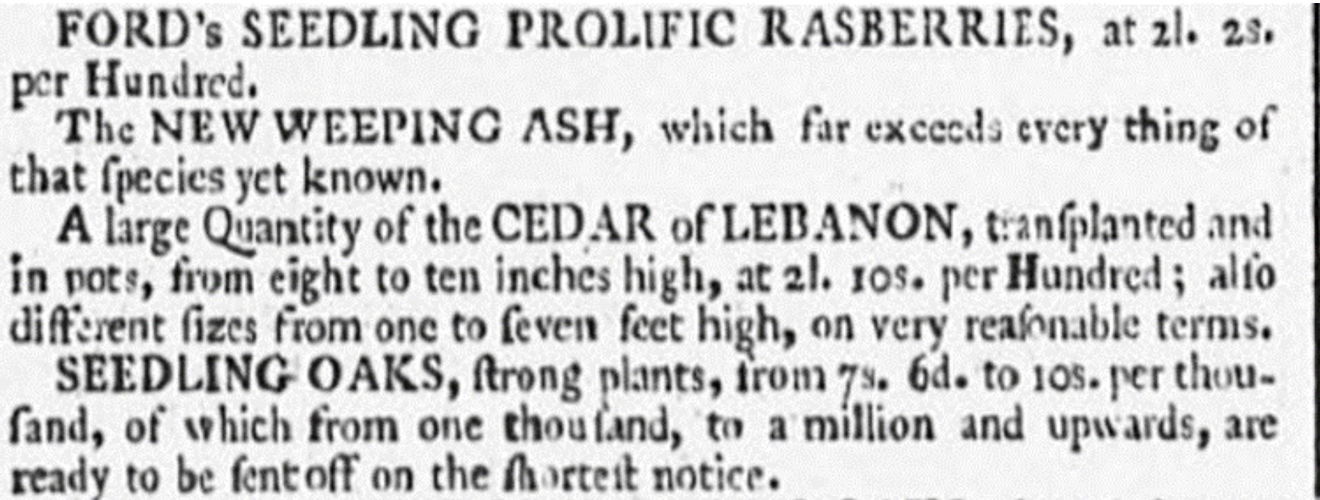
The weeping ash was developed as an attractive ornamental tree. Its popularity grew during the Victorian era and they became very much sought after. The two at Armstrong Cottages have lived a long time and have witnessed many changes during their life.
Rothbury Motors - Lee's Garage
In 1909, for example, when they were just saplings, they may have been pleased to note a change in the law about the cars driving past them. Rothbury agreed a speed limit of 10 mph) This would have affected John Lee, when he, in 1912, got his first char-a-banc, and in 1913 his first garage was built. The trees would have seen, from 1919, the taxis and buses run by C F Wright, who had been a mechanic at John Lee's garage, pass by on their journeys filled with excited passengers. (Later, in 1953, Wright bought out Lee's Garage). Rothbury Motors website tells us that their current premises were:
“...built by John Lee, a plumber, in 1913 as a garage to maintain motorcars and motorbikes. There was a machine shop, blacksmiths forge and joiners shops, some of the original lifting cranes and equipment are now in the Beamish Open Air Museum in their garage. John Lee was a forward-thinking man and in the early 1920's built buses on Lancia chassis, offering service to Newcastle Upon Tyne and the surrounding area.
In the late 1930s the garage was taken over by Linden Wright, who further developed the business with an agricultural and car sales dealerships as well as transporting the British Army and prisoners of war to work on the local farms with his buses. After the war he created further local bus services from Rothbury to Blackpool and other holiday resorts as well as a service to London in spite of having to sit on slatted wooden seats!"
Rothbury Motor Garage's interesting history can be viewed here: Heritage Locations (nationaltransporttrust.org.uk)
You can view a lovely series of images of Lee's Garage, and the different vehicles he owned, here:
https://youtu.be/9VGjKYQ2KY0

In 1920, near to the cottages, there was a 'murderous attack' on a Rothbury Police Constable. Although our trees would not have witnessed this, they would have been interested to watch a film being made in 1913, which has footage of brave PC Sinton, right in front of them. The film demonstrates the efficacy and power of the Rothbury Fire Engine. You can read about both here, as well as watching the film, which is linked into the Gazette article: "Murderous Attack on Local PC"! (rothburytrees.uk)
The trees would have got very wet 'feet' during the terrible flooding of 1927. The water is reported to have been 'waist deep' at Town Foot. Elsewhere in Newcastle, The North Mail reported on August 9th 1927, 'Inch and Half in Six Hours - Merciless Rainfall in North - Geyser Spectacle in High Heaton' However, the worst Rothbury floods in living memory were several decades later, in 2008. The current floodgates, which the weeping ash trees have a perfect view of, replaced the earlier ones, in 2014/15.
A surprising thing the trees would have witnessed, perhaps, in 1956, would be when Brian Tait, who worked for Thomas Muckle, was commissioned to transport an elephant, Susie, to Almeira in Southern Spain. The specially adapted truck, fortified to carry the 3 1/2-ton Susie, would have been driven past the trees, as Brian (from then on known as Sabu the Elephant Boy to his colleagues) drove past Armstrong Cottages, at the beginning of the journey. See Chronology | Rothbury
Ash Dieback If you observe the two trees now, you will, unfortunately, see the evidence of ash dieback along the trunk and on the branches, and crown of the trees. This disease from mainland Europe is a great threat not only to these two, but to all of our ash trees. Ash trees are a beautiful native tree, and its devastation by this disease is indeed a tragedy. See more here: The tragedy which goes by the name of Ash Dieback (rothburytrees.uk) An academic article: Ash dieback in the UK: A review of the ecological and conservation implications and potential management options — The University of Aberdeen Research Portal (elsevier.com)
Given the size and age of the Armstrong Cottages trees, however, it must be noted that they still provide a good habitat for a range of species. One of our tree wardens, Professor Darren Evans, has witnessed a nuthatch, amongst other creatures, making good use of them.
The kind of species associated with ash trees have been listed in the academic report linked above: “We assess the potential ecological impact of Hymenoscyphus pseudoalbidus (ash dieback) on Fraxinus excelsior in the UK. 953 species were identified as associated with F. excelsior trees: 12 birds, 28 mammals, 58 bryophytes, 68 fungi, 239 invertebrates, 548 lichens. Forty-four 'obligate' species were identified: 11 fungi, 29 invertebrates and 4 lichens; and 62 'highly associated' species”.
As no single alternative tree can replicate this, the loss of ash trees is of major consequence.
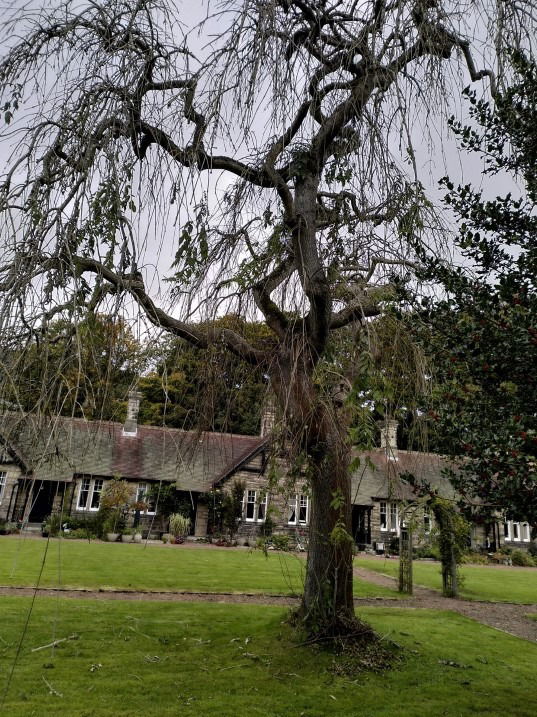
You can see in the picture above, the very clear evidence of Ash Dieback.
We can but hope that these two trees will remain strong and in place for as long as possible. I did go to collect keys from them in the autumn 21, but was saddened to find that none had been produced. I will make a point of looking in autumn 2022 and see if we can grow some children from these two iconic and beautiful trees.
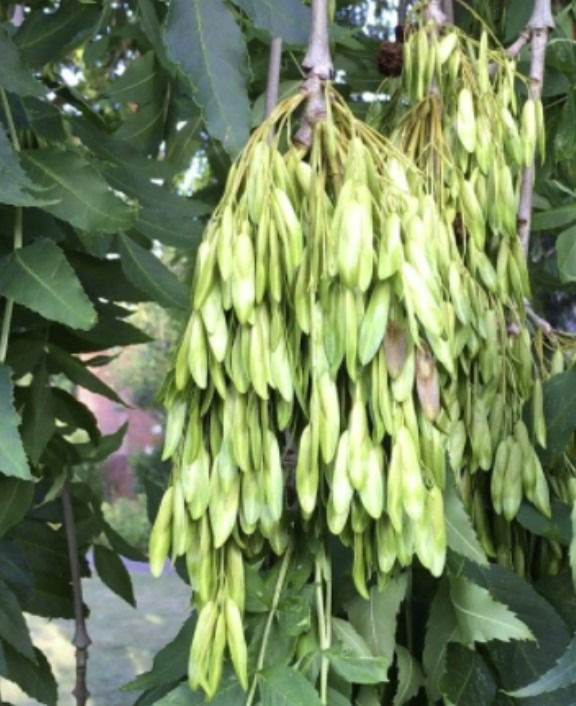
No keys were on the Rothbury weeping ash, but I am hoping for bunches like these, next year.
With sincere thanks to the generous help of Professor Darren Evans, Marjorie Davey, Mike Todd. All errors my own, of course.
A shorter version of this article has been published in the Northumberland Gazette: Rothbury weeping ash trees have witnessed astonishing changes over last century | Northumberland Gazette Katie Scott March 2022
UPDATE
In Spring 2024, the two trees were felled, and weeping willow trees were planted in their place. The end of weeping ash
